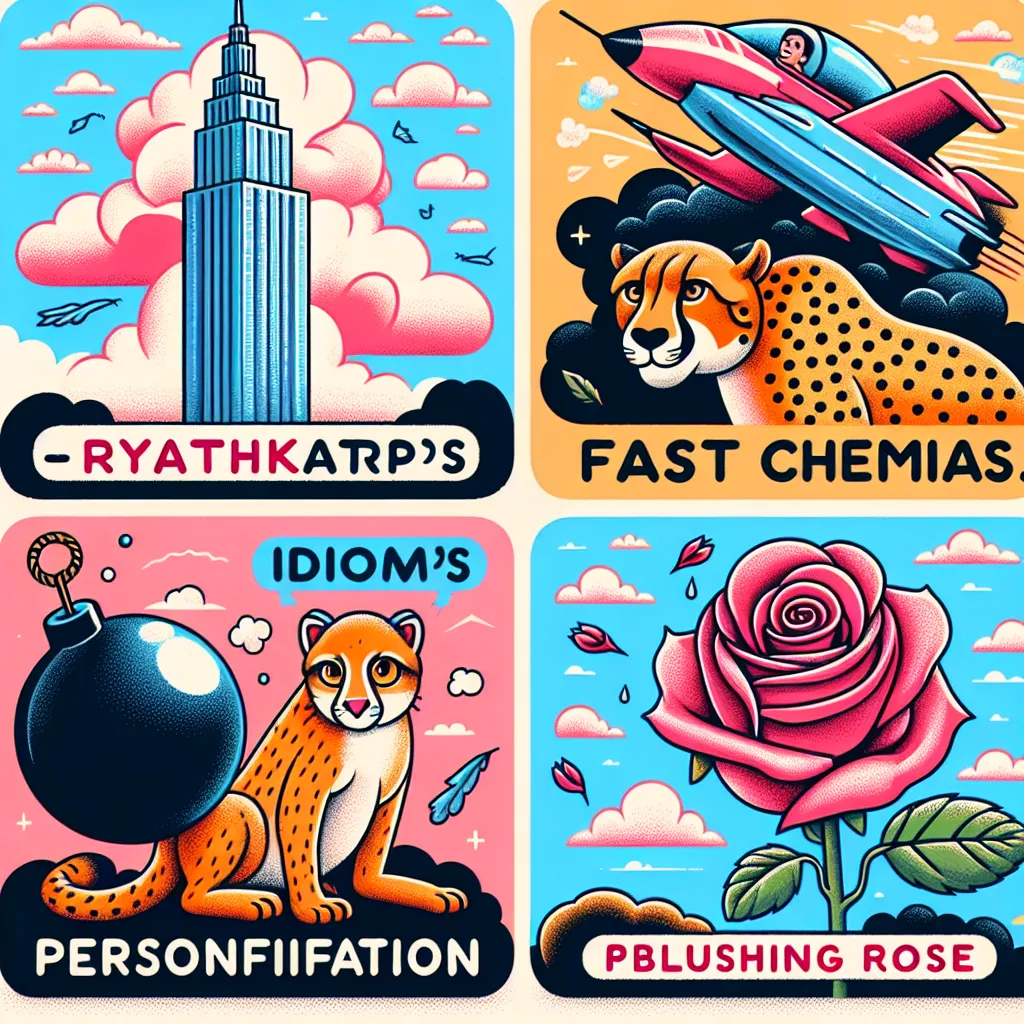Figurative language is a powerful tool in English communication, adding depth and richness to both spoken and written expression. Mastering this aspect of the language can significantly enhance your overall proficiency and help you communicate more effectively in various contexts. This guide will provide you with strategies to improve your understanding and use of English figurative language.
Understanding Figurative Language
Figurative language refers to words or phrases that go beyond their literal meaning to create a more vivid, imaginative, or impactful expression. It includes various literary devices such as metaphors, similes, idioms, and personification, among others. Understanding and using figurative language is crucial for advanced English learners as it allows for more nuanced and expressive communication.
 Figurative Language Concept
Figurative Language Concept
Common Types of Figurative Language
1. Metaphors
Metaphors are comparisons between two unlike things without using “like” or “as.” They create a direct link between the two concepts.
Example: “Life is a rollercoaster.”
Strategy: To master metaphors, start by identifying them in everyday language and literature. Practice creating your own metaphors by comparing abstract concepts to concrete objects or experiences.
2. Similes
Similes are comparisons using “like” or “as” to draw a relationship between two different things.
Example: “She’s as busy as a bee.”
Strategy: Look for similes in songs, poems, and daily conversations. Try to create similes to describe your own experiences or emotions.
3. Idioms
Idioms are phrases with meanings that cannot be deduced from the individual words.
Example: “It’s raining cats and dogs.”
Strategy: Learn idioms in context through authentic materials like movies, TV shows, and books. Keep an idiom journal and practice using them in conversations.
4. Personification
Personification attributes human characteristics to non-human things or ideas.
Example: “The wind whispered through the trees.”
Strategy: Practice identifying personification in literature and try creating your own examples by giving human qualities to objects or abstract concepts in your surroundings.
Strategies for Mastering Figurative Language
1. Immerse Yourself in Authentic English Content
Exposure to native English content is crucial for understanding how figurative language is used naturally.
- Read extensively: Choose a variety of genres including fiction, poetry, and newspapers.
- Watch English-language media: Pay attention to dialogue in movies, TV shows, and YouTube videos.
- Listen to podcasts and music: Note how figurative language is used in different contexts.
2. Keep a Figurative Language Journal
Maintaining a journal dedicated to figurative expressions can significantly boost your learning.
- Record new expressions you encounter.
- Write down the context in which you found them.
- Practice using these expressions in your own sentences.
3. Use Visualization Techniques
Creating mental images can help you better understand and remember figurative language.
- When you encounter a new metaphor or simile, try to visualize it.
- Draw simple sketches to represent idioms or personification examples.
4. Practice Regular Analysis
Develop a habit of analyzing figurative language when you encounter it.
- Ask yourself: What is being compared? Why was this comparison chosen?
- Consider how the figurative language enhances the meaning or emotional impact of the text.
5. Engage in Creative Writing Exercises
Writing is an excellent way to practice using figurative language actively.
- Write short stories or poems incorporating different types of figurative language.
- Participate in creative writing workshops or online forums to get feedback.
6. Use Language Learning Apps and Resources
There are numerous digital tools designed to help learners master figurative language.
- Apps like Idiom of the Day or Metaphor and Simile Guides.
- Online quizzes and games focused on figurative language.
7. Join Language Exchange Programs
Interacting with native speakers can provide valuable insights into the use of figurative language.
- Participate in language exchange platforms like Tandem or HelloTalk.
- Discuss idioms and expressions with native speakers to understand their usage and cultural context.
Common Pitfalls and How to Avoid Them
-
Overuse: While figurative language can enhance communication, overusing it can make your speech or writing seem forced or unnatural.
Tip: Use figurative language sparingly and appropriately to the context.
-
Misinterpretation: Some learners might take figurative expressions literally, leading to confusion.
Tip: Always consider the context and if unsure, ask for clarification.
-
Cultural Differences: Figurative language often has cultural roots, which can be challenging for non-native speakers.
Tip: Learn about the cultural background of expressions to understand their true meaning and appropriate usage.
-
Incorrect Usage: Using figurative language incorrectly can lead to miscommunication.
Tip: Practice using new expressions in various contexts and seek feedback from native speakers or teachers.
Next Steps in Your Learning Journey
- Set specific goals: For example, aim to learn and use five new idioms each week.
- Create a study group: Share and discuss figurative language with other learners.
- Take advanced English courses: Look for classes that focus on literary devices and creative writing.
- Challenge yourself: Try explaining complex ideas using figurative language in your daily conversations or writing.
Mastering English figurative language is a journey that requires patience, practice, and persistence. By incorporating these strategies into your learning routine, you’ll gradually enhance your ability to understand and use figurative expressions effectively. Remember, the key is consistent exposure and practice. Don’t be afraid to make mistakes – they’re an essential part of the learning process.
For more tips on improving your English skills, check out our articles on tips for learning English by writing short stories and strategies for mastering English through storytelling. These resources can provide additional techniques to complement your figurative language learning journey.
We encourage you to share your experiences and any strategies you’ve found helpful in mastering figurative language in the comments below. Happy learning!




